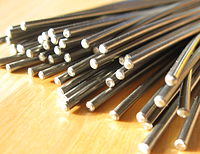
Photo from wikipedia
In the application of additive manufacturing, it is inevitable to use some formed parts with a smaller height. The analysis of various mechanical properties of these formed parts is the… Click to show full abstract
In the application of additive manufacturing, it is inevitable to use some formed parts with a smaller height. The analysis of various mechanical properties of these formed parts is the focus of research. In this paper, the fatigue performance of a titanium alloy specimen with a 10 mm height and electron beam selective melting is studied. By analyzing the structure and phase of the overall fatigue specimen, and then cutting the overall specimen parallel and perpendicular to the additive manufacturing direction, the tensile and fatigue tests in different directions are performed to detect the fatigue cracks at the fracture propagation the way to research. It is found that there are two ways of secondary crack propagation between fatigue bands, and three cracks are generated during the fatigue secondary crack propagation.
Journal Title: Materials Research Express
Year Published: 2021
Link to full text (if available)
Share on Social Media: Sign Up to like & get
recommendations!